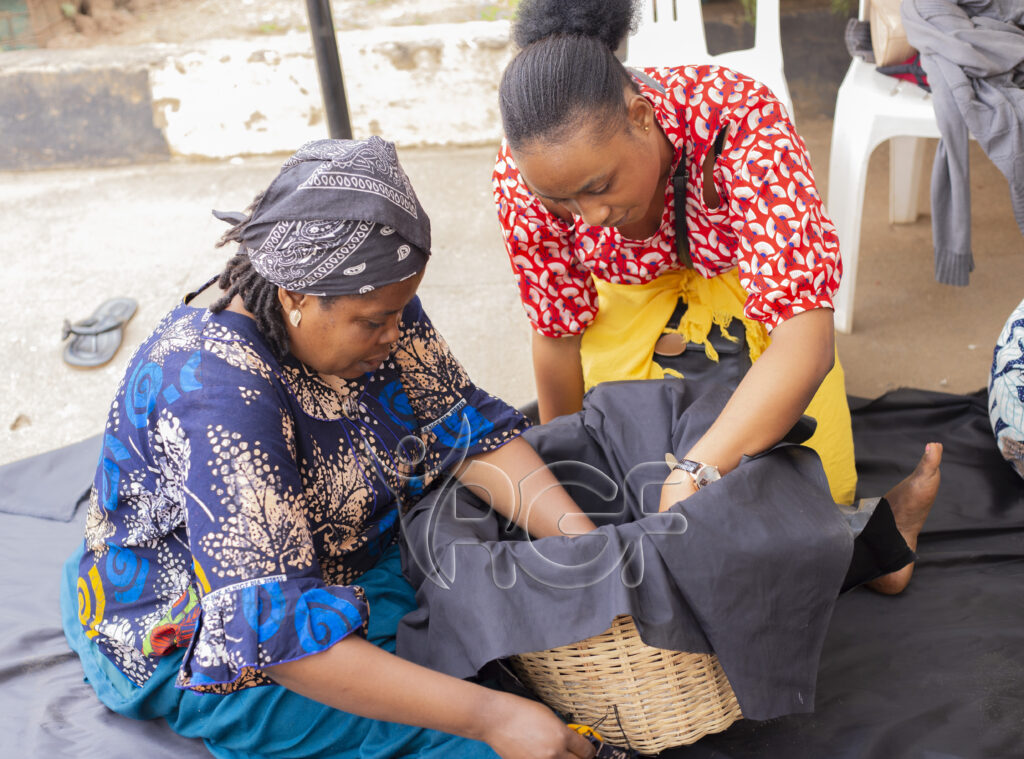Unveiling the Potential Of Black Soldier Fly Farming for waste management.
According to Kampala Capital City Authority (KCCA), on average in Kampala with a solid waste collection coverage of 45%, households, institutions, and markets contribute to a daily supply of 680, 80, and 8 tones of waste daily respectively/. As we delve into the world of black soldier fly farming, the potential to address not only bio-waste but also create sustainable solutions for agriculture becomes even more pronounced.
In the ever-evolving landscape of sustainable practices, a tiny yet powerful player has emerged—the black soldier fly. Far from being just another insect, did you know that these industrious creatures play a pivotal role in sustainable agriculture, aligning seamlessly with global goals for a more sustainable future? According to sciencedirect.com recent statistics, the black soldier fly has become a game-changer, reshaping the way we approach waste management and agriculture.

(Photo by lutaaya shafik)
And here’s another compelling statistic: the global market for BSF products is projected to reach a staggering $3.4 billion by 2030. This surge is driven by increasing demand for animal feed, the rise in global meat consumption, a growing aquaculture industry, and expanding government support for insect meals (Meticulous Market Research, 2021). These figures underscore the immense economic opportunities within the black soldier fly farming industry.
The Black Soldier Fly: A Brief Introduction
Before we delve into the intricacies of farming procedures, let’s acquaint ourselves with our diminutive protagonist—the black soldier fly (BSF). Unlike common houseflies, black soldier flies are not disease carriers; their primary mission isn’t to disrupt our picnics. These beneficial insects are voracious eaters, with their larvae holding the key to sustainable farming.
Life Cycle and Reproduction
Understanding the life cycle of the black soldier fly is fundamental to successful farming. The cycle commences with the female laying an impressive mass of about 500 eggs in cracks and crevices, often in decaying matter like dung, carrion, garbage, and other organic waste. This egg mass becomes the cornerstone for the ensuing stages of the black soldier fly life cycle.
The eggs undergo a rapid transformation, hatching into larvae in approximately four days. This marks the commencement of a remarkable journey where these larvae evolve into voracious consumers of organic waste, significantly contributing to the efficiency and sustainability of the farming process.
Starting at about 1mm in length, the larvae’ insatiable appetite propels them to a size of 25mm over a growth period of 10 to 28 days. This growth phase is pivotal, as the larvae, driven by their hunger, effectively convert organic waste into nutrient-rich biomass.
Black soldier fly larvae exhibit an impressive capacity to consume substrate, ranging from 25 mg up to 500 mg of fresh matter per larvae per day, resulting in a body length of approximately 27 mm, a width of 6 mm, and a weight of 220 mg at 14 days old. This underscores their efficiency in converting substantial amounts of organic waste into valuable biomass during their growth period.
Following this growth phase, the larvae enter the pupae stage, signaling the next stage of their transformation into adult flies.

(Photo by Lutaaya shafik)
According to Basemera Sarah team lead at RGF(Raising Gabdho foundation) , the Black Soldier Fly proves to be an ideal and sustainable source of nutrition for chickens, boasting a rapid production cycle and high concentrations of protein and calcium. With up to 42.1% crude protein, 34.8% fat, 7.0% crude fiber, and 5.0% calcium, Black Soldier Fly larvae are a nutritious snack suitable for a variety of animals. Whether fed live, frozen, or dried for long-term storage, these larvae can replace up to 10% of a flock’s regular grain, providing a healthy and cost-effective alternative. Integrating Black Soldier Fly larvae into a chicken’s diet not only supports their growth but may also contribute to improved egg-laying performance, making them an essential component for raising healthy hens.
Farming Procedures: Laying the Groundwork
1. Optimal Conditions for Farming
Creating the right environment is paramount for black soldier fly farming success. Thriving in warm, humid conditions, a controlled environment with temperatures ranging between 77°F to 104°F (25°C to 40°C) is considered optimal.
2. Selecting the Right Substrate
The substrate, where the black soldier fly larvae feed, is a critical element. Common substrates include food waste, agricultural by-products, and manure. Beyond serving as a food source, these materials also act as a medium for egg-laying.
3. Harvesting the Larvae
Timing is key when harvesting the larvae, Typically done just before they pupate, this ensures a nutrient-rich harvest. The harvested larvae find application as a protein source in animal feed, effectively closing the loop in sustainable agriculture.

(Photo by Lutaaya shafik)
Benefits of Black Soldier Fly Farming
1. Waste Reduction: Black soldier fly larvae exhibit remarkable efficiency in converting organic waste into biomass, making significant contributions to waste reduction and management.
2. High-Quality Protein: The harvested larvae, rich in protein, emerge as an excellent alternative for animal feed, reducing dependence on traditional protein sources.
3. Bio-conversion: Black soldier flies play a pivotal role in bio-conversion, transforming organic waste into valuable resources.
Aligning with Sustainable Development Goals (SDGs)
Black soldier fly farming aligns seamlessly with several Sustainable Development Goals (SDGs), including:
– SDG 2: Zero Hunger
– SDG 12: Responsible Consumption and Production
– SDG 13: Climate Action
Impact on Uganda’s Economy
In Uganda, black soldier fly farming is gaining momentum as a sustainable practice with significant economic impacts. Recent statistics indicate:
– The industry has witnessed a remarkable 10% increase in employment opportunities.
– Annual revenue from black soldier fly farming has become a noteworthy contributor to Uganda’s GDP.

(Photo by Lutaaya shafik)
Black Soldier Fly Metrics & Yields
When it comes to metrics, the yield (dry weight) per day of self-harvesting BSF larvae—mainly pre-pupae—per square meter fed food scrap waste is approximately 0.2 Kg (0.44 lbs) per day (73 Kg per year). Doubling this value for a 2 square meter bin provides a perspective. To put it in context, one metric ton (MT), slightly more than a ton, underscores the efficiency and scalability of black soldier fly farming.
Market Potential for Black Soldier Fly Fertilizer Products
Delving into market potential, projections indicate a staggering $3.4 billion global market for BSF products by 2030. This surge is driven by increasing demand for animal feed, the rise in global meat consumption, a growing aquaculture industry, and expanding government support for insect meals (Meticulous Market Research, 2021). This highlights significant economic opportunities within the black soldier fly farming industry.
Making Money with Black Soldier Fly Farming
For the uninitiated, black soldier flies excel as rapid dig esters of waste food material, producing protein and fat-rich larvae suitable for feeding chickens, fish, and reptiles. Beyond the environmental benefits, there exists notable income potential in producing black soldier flies as a business—making it a viable option for both large-scale enterprises and small-scale homesteads.

(Photo by Lutaaya shafik)
Basically: black soldier fly farming transcends novelty; it represents a sustainable solution to pressing environmental challenges while leaving an indelible mark on Uganda’s economic landscape. By embracing and implementing the right procedures, we can harness the power of these remarkable insects to create a more sustainable and eco-friendly future.
In the grand scheme of sustainable practices, black soldier fly farming stands as a beacon of innovation—a testament to the potential for positive change in our approach to waste management, agriculture, and economic growth. Let’s collectively welcome the black soldier fly as a valued partner in our journey toward a greener, more sustainable world.
The journey undertaken by RGF underscores the transformative power of innovation and community collaboration in addressing waste management challenges in Kampala.
Inspired by RGF’s transformative journey, the narrative encourages readers to embrace sustainable waste management practices in their communities, echoing the impact of change initiated in Uganda’s capital.
Author’s Note (Optional):
From the heart of Kampala, Uganda, Mr. Tukuza Meleki Andre reflects on the profound impact collective efforts can have on transforming waste management practices, fostering economic growth, and paving the way for a cleaner, sustainable world.
Citations:
Meticulous Market Research, 2021.







Im so surprised and happy ,wow ididn’t know that black-soldier fly farming ,keep it up ,go greeen ,
BSFfarming ,
sustainability.
Great insights on the Black Soldier Fly’s pivotal role in waste reduction, nutrient-rich compost, and sustainable protein production. The efficiency of BSF larvae in waste management and their contribution to soil fertility is truly remarkable. The concept of BSF as a protein source for livestock aligns with the growing need for sustainable alternatives. Kudos for highlighting the versatility and importance of the Black Soldier Fly in such a concise and informative manner. This blog has inspired me to explore integrating BSF into our sustainability efforts. Thank you for the valuable content!”